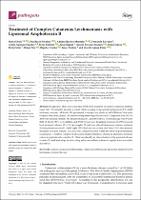Resum
Paraules clau
Leishmania; Amfotericina B liposomal; Teràpia sistèmica
Citació recomanada
Ubals M, Bosch-Nicolau P, Sánchez-Montalvá A, Salvador F, Aparicio-Español G, Sulleiro E, et al. Treatment of Complex Cutaneous Leishmaniasis with Liposomal Amphotericin B. Pathogens. 2021 Oct;10(10):1253.
Audiència
Professionals
Empreu aquest identificador per citar i/o enllaçar aquest document
https://hdl.handle.net/11351/7496Aquest element apareix a les col·leccions següents
- HVH - Articles científics [2970]
Els següents fitxers sobre la llicència estan associats a aquest element:


